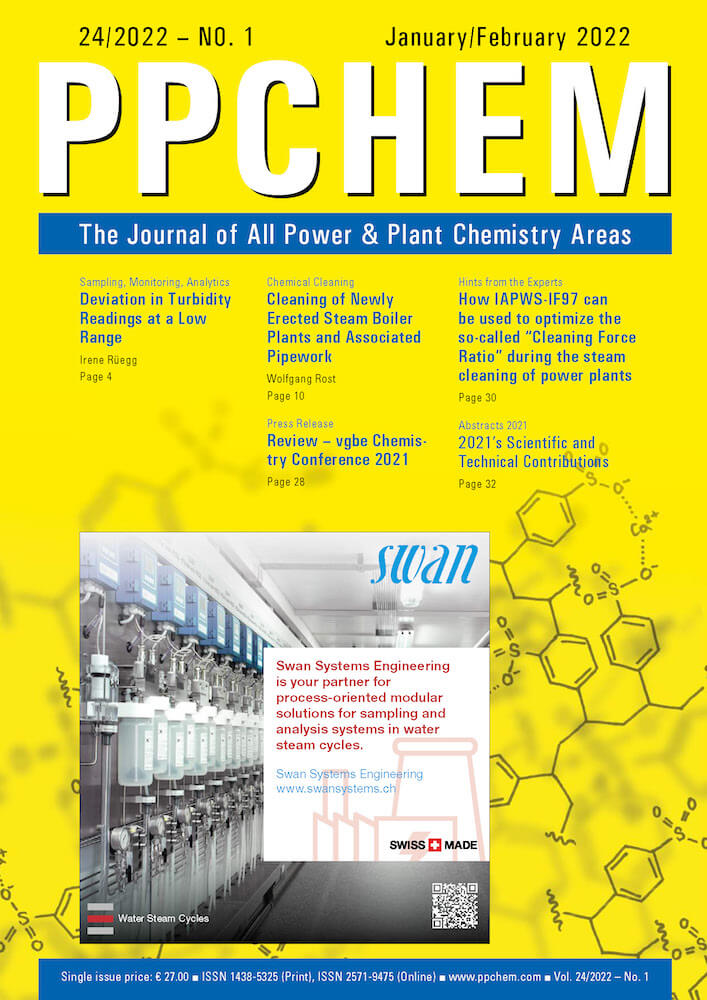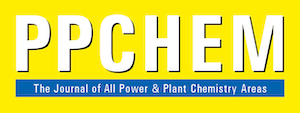
For members only
ABSTRACTS
Deviation in Turbidity Readings at a Low Range
Irene Rüegg
Various factors contribute to deviations encountered in low turbidity readings by different analyzers. Turbidity measurement is instrument-dependent; different instruments calibrated with formazine according to the standard methods only show identical readings on a sample if the instruments incorporate the deviation factors. This article examines the interferences that affect a “zero” measurement and demonstrates how the concept of the Swan AMI Turbiwell turbidity analyzer reduces these inaccuracies.
PPCHEM® 2022, 24(1), 4–8
For Members only
Cleaning of Newly Erected Steam Boiler Plants and Associated Pipework
Wolfgang Rost
Experience gained over the years has shown that the strict adherence to prudent industry practice regarding the clean assembly of steam generator and water/steam cycle systems is the key to quickly establishing normal and trouble-free steam turbine operation of newly built power plants. It is therefore most valuable to understand what kinds of contamination can occur in what production step, what adverse consequences they imply, and how to generally avoid them by setting up very simple guidelines to start with. In addition, it is very helpful to know what sort of remedies exist as effective corrective measures if things go wrong in the first place. The knowledge of what state-of-the-art cleaning procedures exist and how they are conducted properly is also a very important key to success. If all the aforementioned points are adhered to, a reduction in execution time and money expenditure will be the result at the end of the day.
PPCHEM® 2022, 24(1), 10–23
For Members only
Review – vgbe Chemistry Conference 2021
Andreas Wecker and Sabine Kuhlmann
The 57th vgbe Chemistry Conference took place again as an attendance event. As usual, this chemistry conference was also accompanied by a trade exhibition with 21 national and international exhibitors. The approximately 160 participants were offered an interesting lecture programme.
PPCHEM® 2022, 24(1), 28–29
HINTS FROM THE EXPERTS
How IAPWS-IF97 can be used to optimize the so-called “Cleaning Force Ratio” during the steam cleaning of power plants
Throughout the entire process of the fabrication and construction of newly erected power plants, contaminants are introduced into the systems of the steam generator and the water/steam cycle due to the nature of the work. Some of these contaminants may not be removed successfully during chemical cleaning. Thus, due to the cleanliness requirements regarding the absence of particles, steam systems of power plants must undergo steam-blow operation prior to commencing the first steam admission to the turbine.
Therefore, all steam pipes routed to the steam turbine must be steam-blown by using enough “force” to remove solid contaminants effectively. The so-called “Cleaning Force Ratio” (CFR) is used to determine whether this required “force” is achieved during steam cleaning.
PPCHEM® 2022, 24(1), 30–31
For Members only
2021’s Scientific and Technical Contributions
PPCHEM® 2022, 24(1), 32–40

